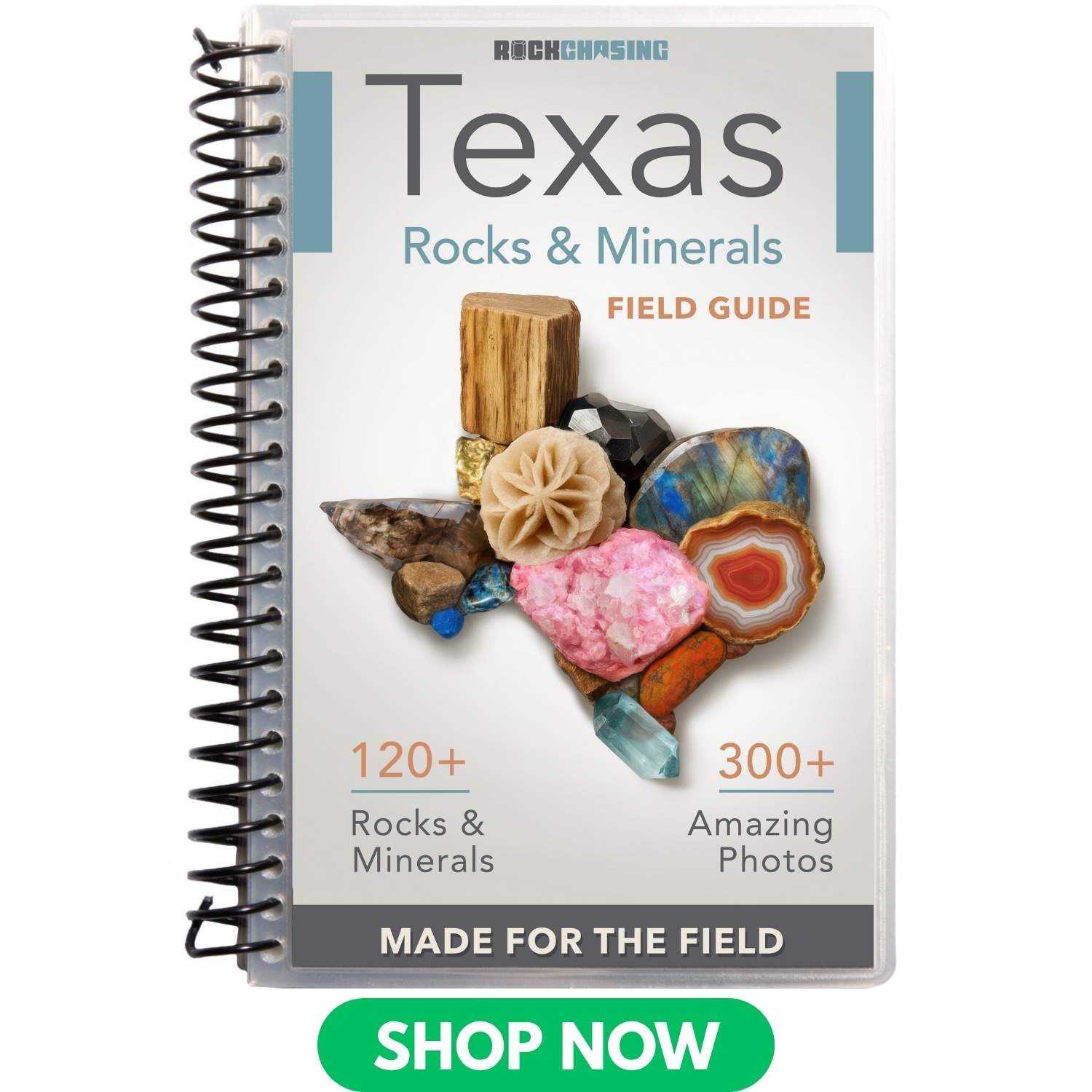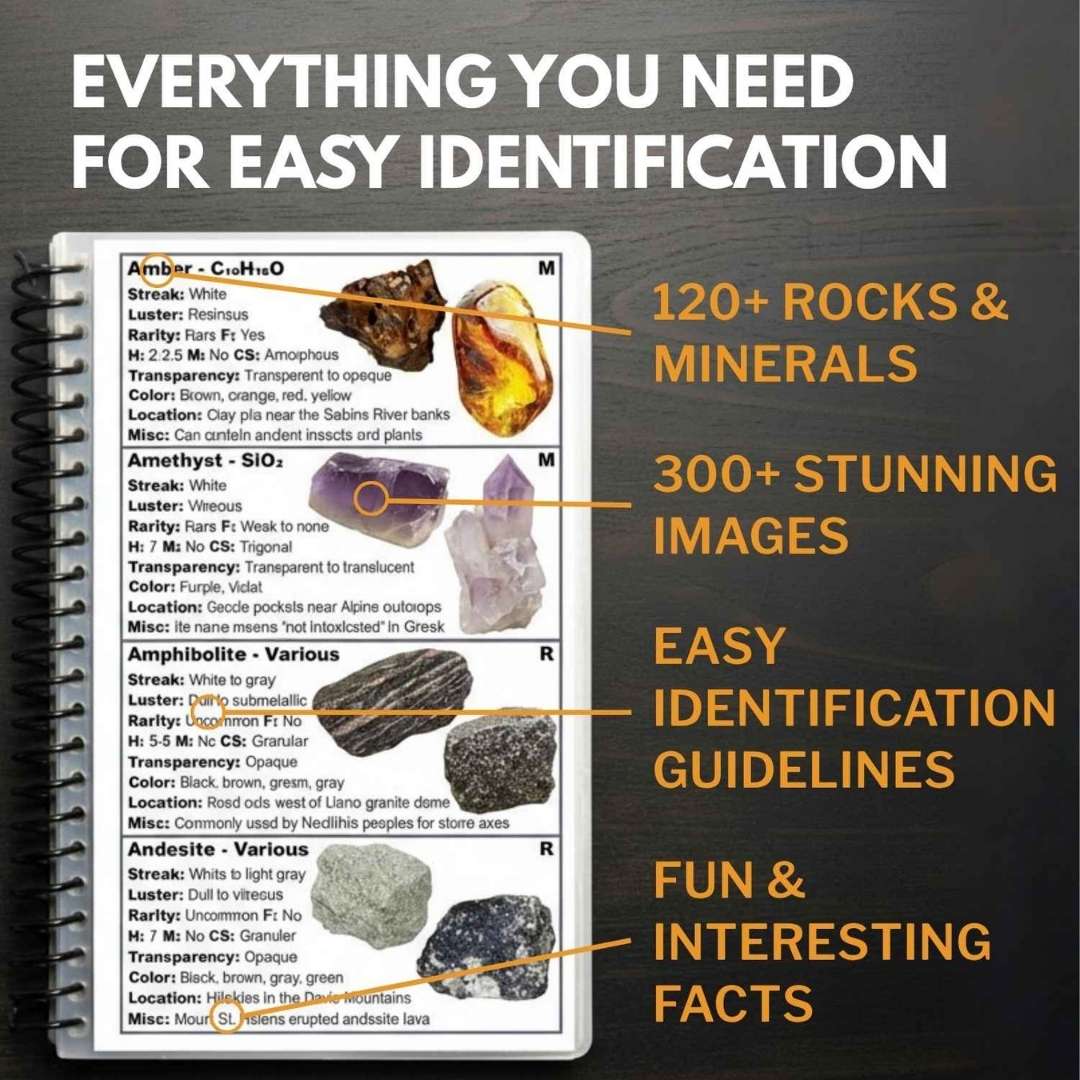Texas rocks tell stories of ancient volcanic activity that brought beautiful Labradorite to the state. This flashy stone catches everyone’s eye with its blue and green shimmer.
Local rockhounds often spot Labradorite pieces in creek beds and rocky outcrops across central Texas. The stone made its way here millions of years ago when molten rock cooled deep underground.
Many rock collectors come to Texas hunting for this special crystal. Its color-changing effect, known as labradorescence, makes it a favorite among crystal enthusiasts and jewelry makers. The best finds usually turn up after heavy rains wash away loose soil and expose new specimens.
You’ll have everything you need here to track it down, and the only thing that makes the search easier is Rock Chasing’s Texas Rocks & Minerals Identification Field Guide. It keeps you from mistaking common stones for labradorite or walking right past a rare piece glowing in the sunlight.
How Labradorite Forms Here
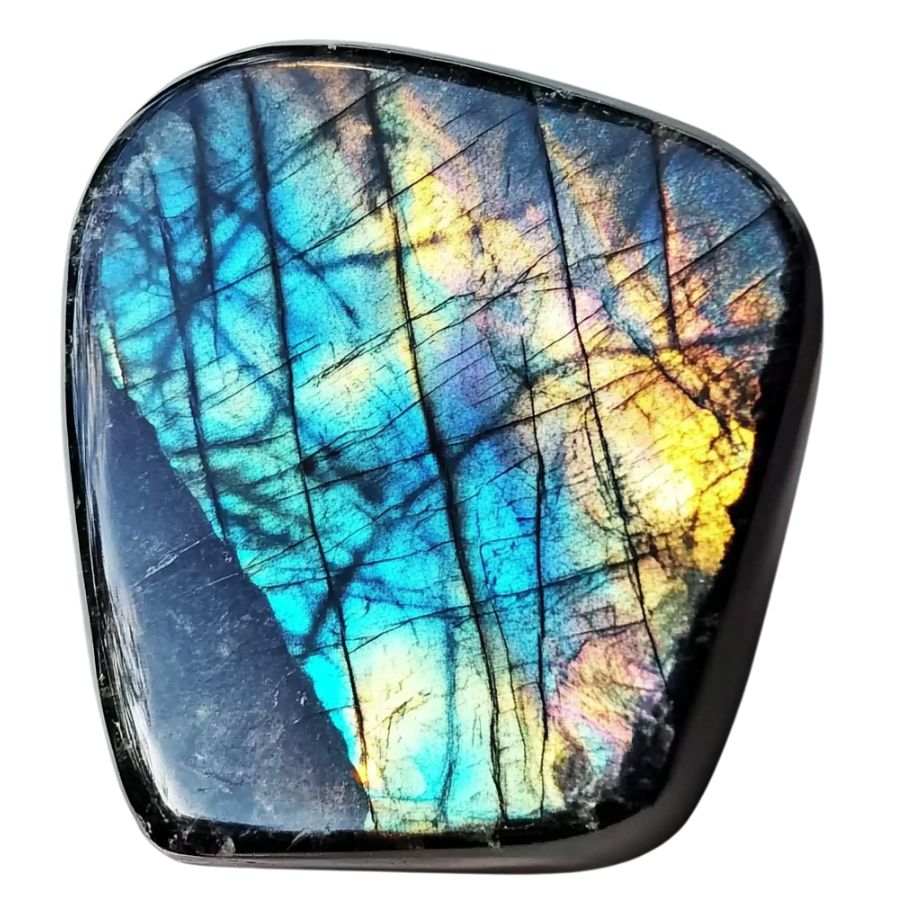
Labradorite forms deep underground when magma slowly cools and crystallizes. The process happens when different minerals separate while cooling, creating thin layers stacked on top of each other. These layers have slightly different chemical makeups, usually about 1 micron thick.
When light hits these layers, it creates that stunning blue-green flash we love, called labradorescence. The stone starts out as a mix of calcium, sodium, aluminum, and silicate minerals.
As it cools, these minerals organize themselves into this layered pattern, which happens most often in places where magma intrudes into the surrounding rock. It’s like nature’s own light show, frozen in stone.
Types of Labradorite
Labradorite comes in several distinct varieties. Each type exhibits special qualities that make it sought after by collectors.
Blue Labradorite
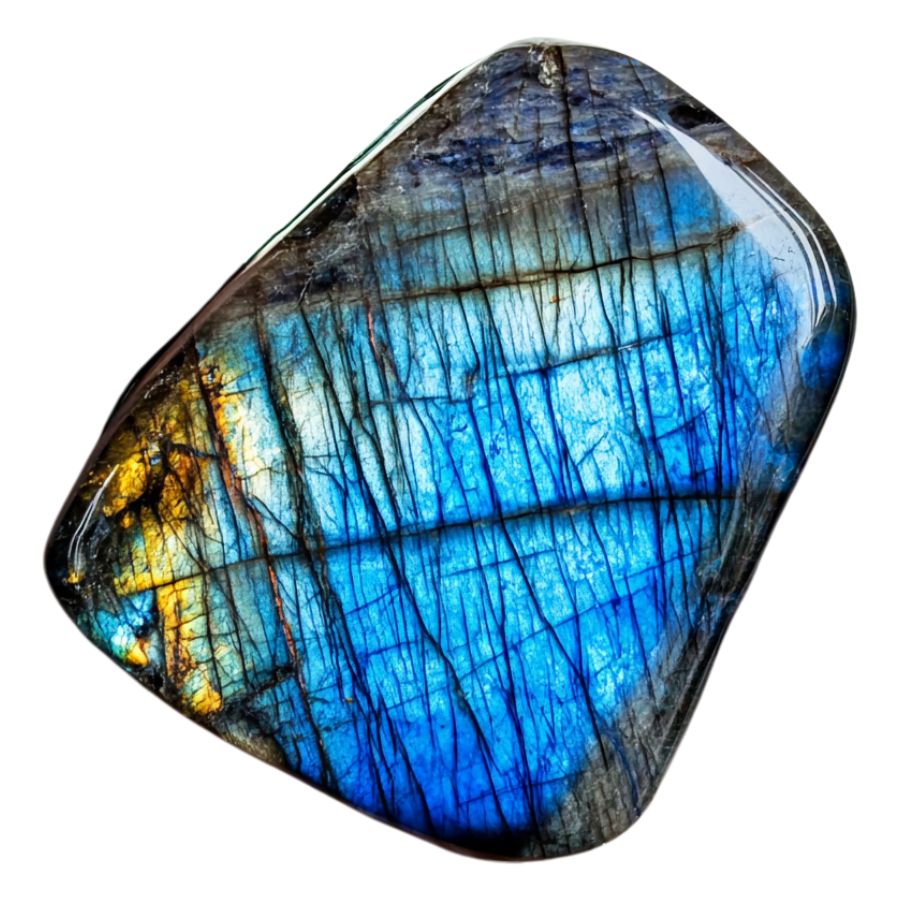
Blue Labradorite stands out for its remarkable blue iridescence against a dark gray or black background. When light hits the stone’s surface, it creates a stunning display of electric blue flashes, sometimes accompanied by hints of green or violet.
The blue flashes appear most vivid when viewing the stone from specific angles, creating an almost magical transformation as you rotate it. This effect is often compared to the ethereal beauty of the Northern Lights.
Exceptional specimens display an intense, electric blue flash that covers a large portion of the stone’s surface. Some pieces also show secondary colors like aqua or sea green, adding depth to their visual appeal. The contrast between the dark base and bright blue flashes makes each piece unique.
Golden Labradorite
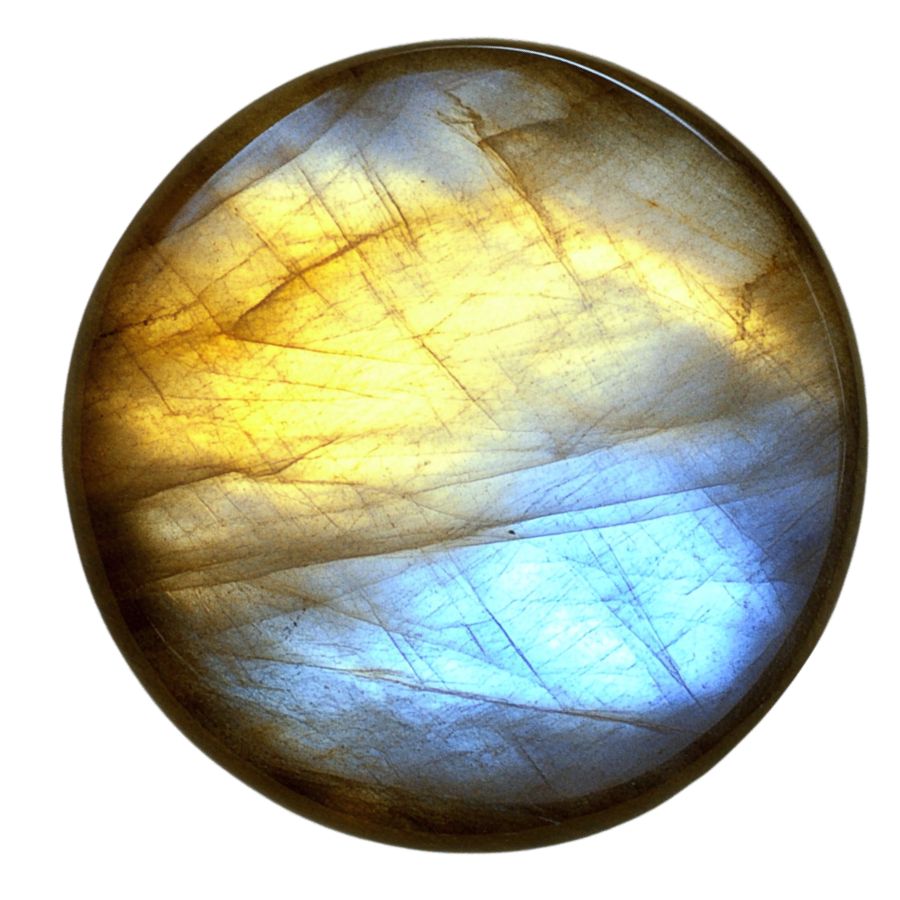
Golden Labradorite displays a mesmerizing golden-yellow sheen that sets it apart from other varieties. The stone’s surface exhibits brilliant flashes of gold and amber, creating a warm, sun-like glow that seems to emanate from within. These golden rays often appear alongside subtle hints of green or champagne colors.
What makes Golden Labradorite special is its ability to display multiple golden hues simultaneously. Some specimens show a range of colors from pale yellow to deep amber, creating a multi-dimensional effect.
The golden flash can vary in intensity and coverage, with premium specimens showing broad, bright areas of gold schiller.
If you want REAL results finding incredible rocks and minerals in Texas you need one of these 👇👇👇
Finding the coolest rocks in Texas isn’t luck, it's knowing what to look for. Thousands of your fellow rock hunters are already carrying Rock Chasing field guides. Maybe it's time you joined the community.
Lightweight, mud-proof, and packed with clear photos, it’s become the go-to tool for anyone interested discovering what’s hidden under our red dirt.
Join them, and make your next rockhounding trip actually pay off.
📘 Order the Texas Field Guide Now →
What makes it different:
🚙 Field-tested across Texas rivers, ranchlands, and roadcuts.
📘 Heavy duty laminated pages resist dust, sweat, and water.
🧠 Zero fluff — just clear visuals and straight-to-the-point info.
📍 Find hidden gems like Blue Topaz, Texas agate, and petrified wood fast.
⭐ Rated 4.8★ by real collectors who actually use it in the field.
Rainbow Moonstone
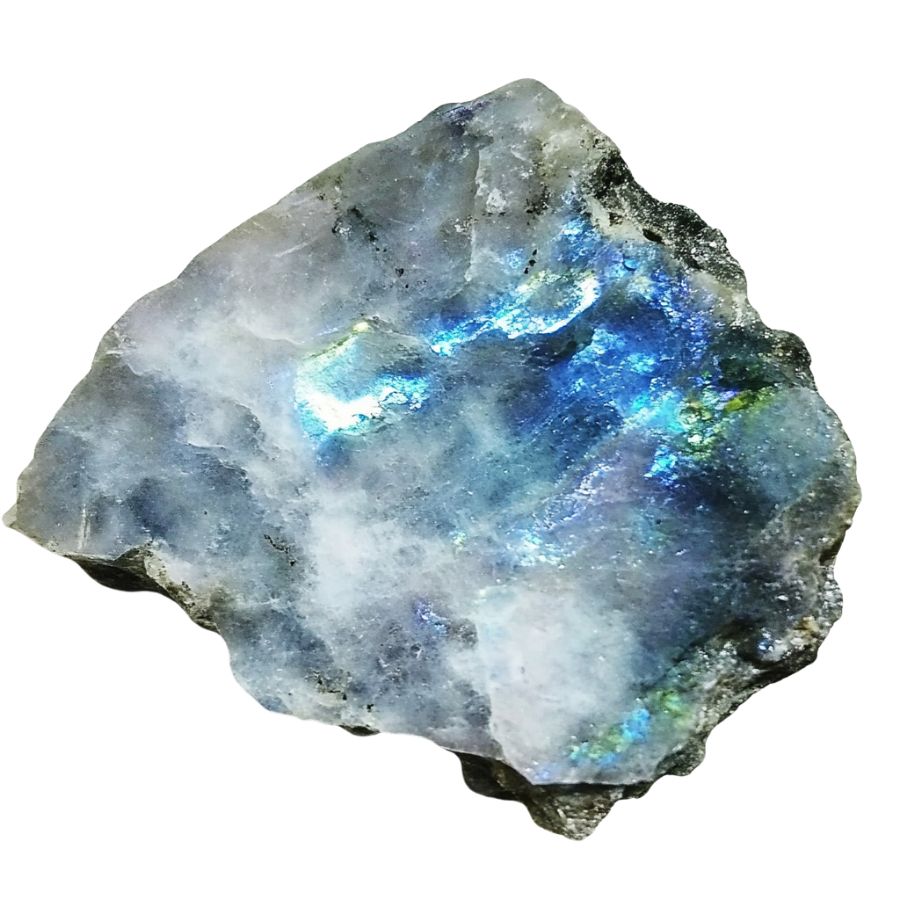
Rainbow Moonstone Labradorite exhibits a distinctive white or colorless base with an enchanting blue sheen that floats across its surface. Blue sheen is often accompanied by flashes of other colors, including pink, yellow, and green.
This stone’s most captivating feature is how its colors appear to float just beneath the surface, creating an almost three-dimensional effect. As light moves across the stone, these colors shift and change, revealing new patterns and combinations. This creates a dynamic display that seems to change with every movement.
The stone’s transparency can range from translucent to semi-transparent, with the most valued pieces showing excellent clarity beneath their shimmering surface.
Spectrolite
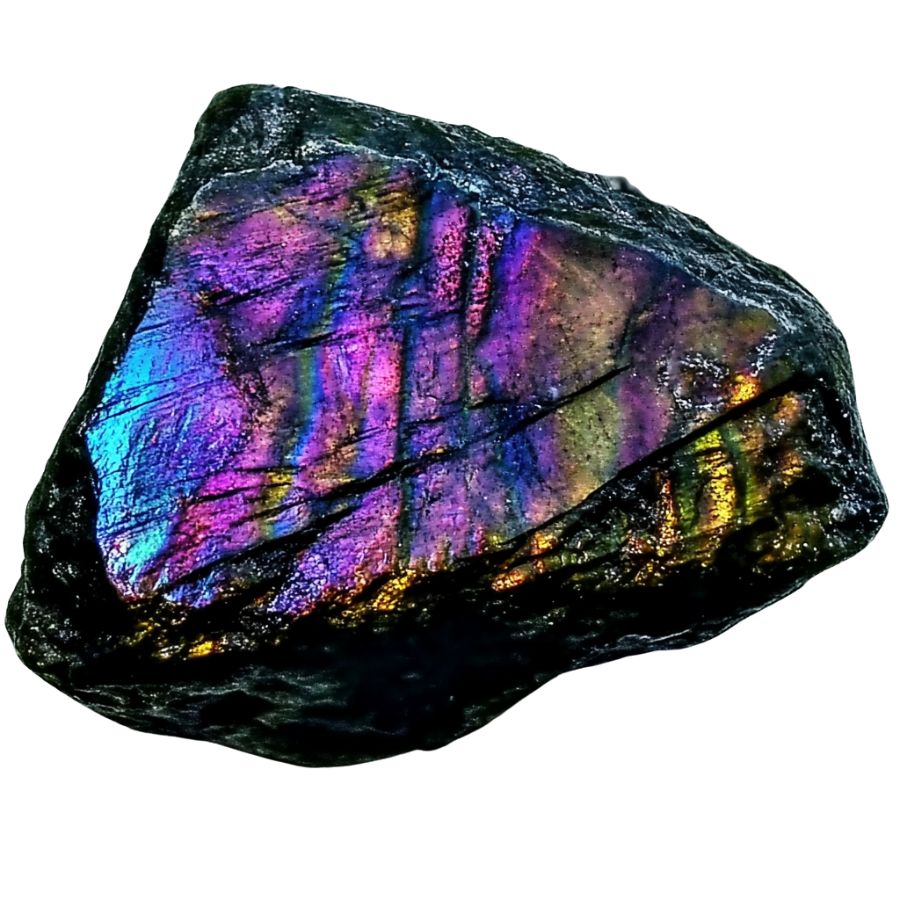
Spectrolite reigns as the most dramatic member of this stone family, with its distinctive jet-black base setting it apart from other varieties.
What makes it truly special is that premium specimens can simultaneously display the complete spectrum of colors, from deep indigo to bright orange, emerald green to royal purple, all in a single piece.
The finest specimens possess what experts call “full-face color,” meaning the vibrant display covers most of the stone’s surface rather than appearing in small patches.
This characteristic, combined with its remarkable color intensity, has earned Spectrolite its reputation as the most visually impressive variety of all similar stones.
Transparent Labradorite
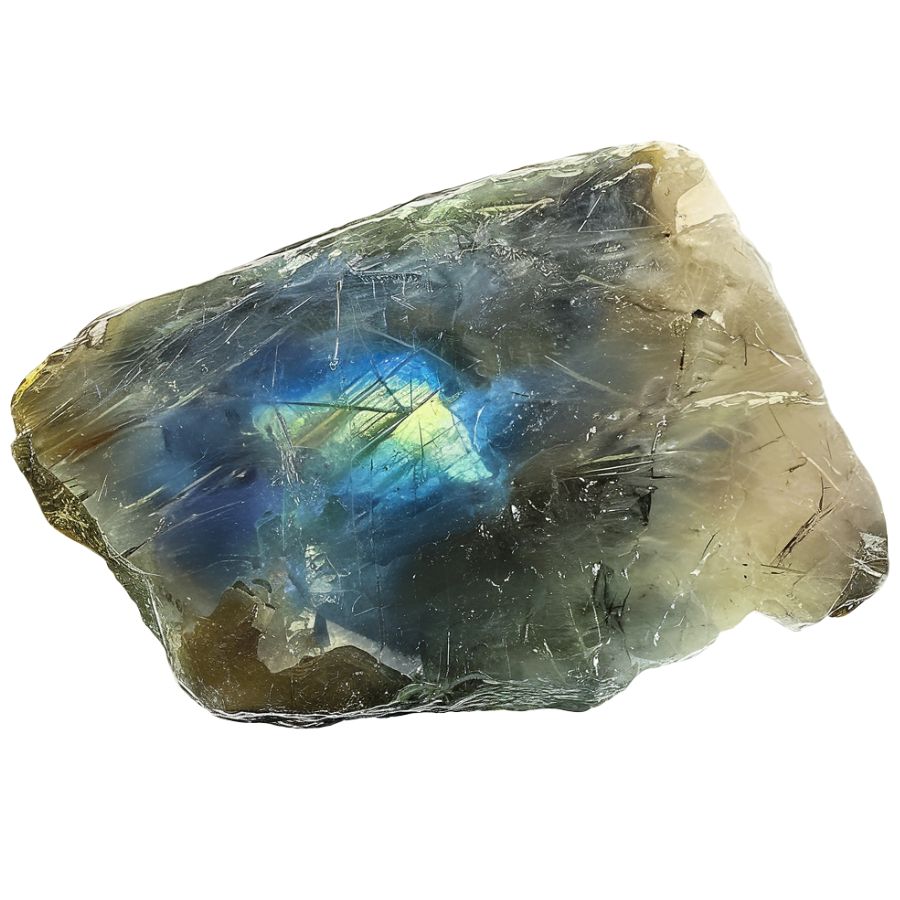
Transparent Labradorite exhibits a remarkable clarity that separates it from its opaque cousins. Crystal-clear areas allow light to pass through, creating an exceptional display of blue flashes against the transparent background.
Natural specimens often show areas of both transparency and translucency. Beautiful color changes occur as you move this stone, with the transparent areas revealing subtle blue sheens that seem to float within the crystal.
Some pieces display additional colors like soft greens or pale yellows, though the blue flash remains dominant.
Remarkable clarity combines with the signature color play to create stones that appear almost liquid-like.
Andesine-Labradorite
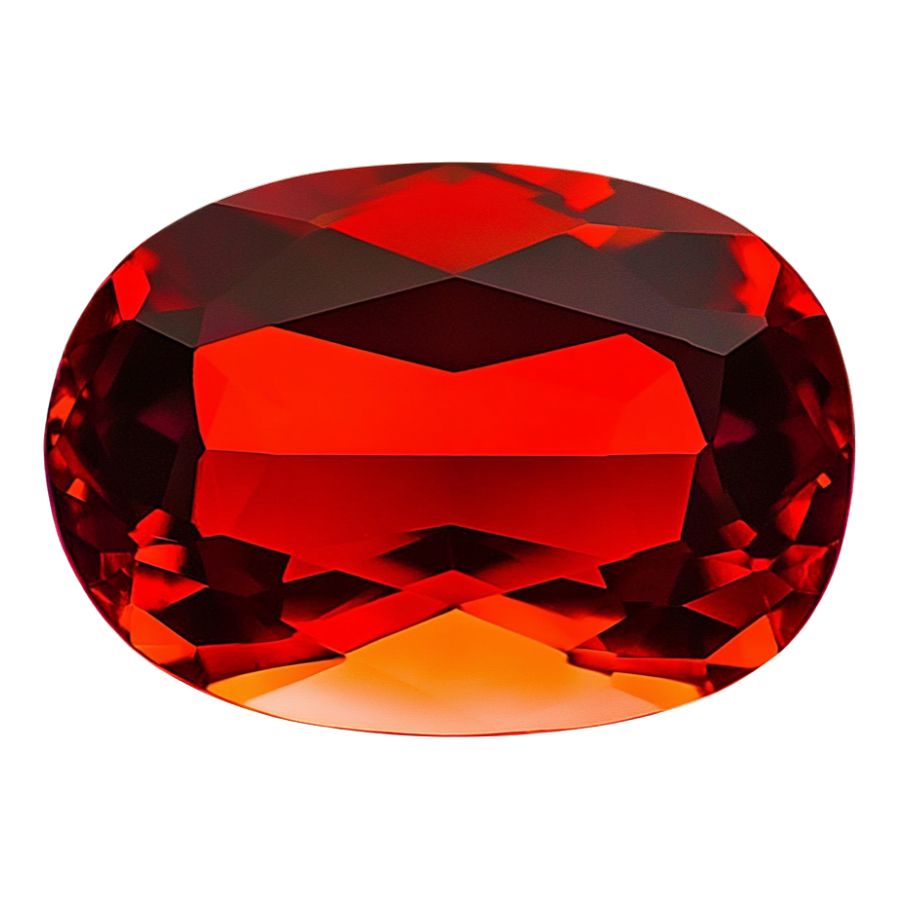
Reddish-orange hues dominate Andesine-Labradorite’s appearance, creating a warm and inviting glow. Delicate green and yellow streaks often appear throughout the stone, adding complexity to its color palette.
Metallic sparkles dance across the surface, different from the typical labradorescent effect. Fresh discoveries of this relatively new gemstone continue to reveal new color combinations.
Striking color variations appear in high-quality pieces, ranging from deep red to bright orange. Many specimens show subtle color zoning, where different hues blend together in distinct patterns.
Black Labradorite
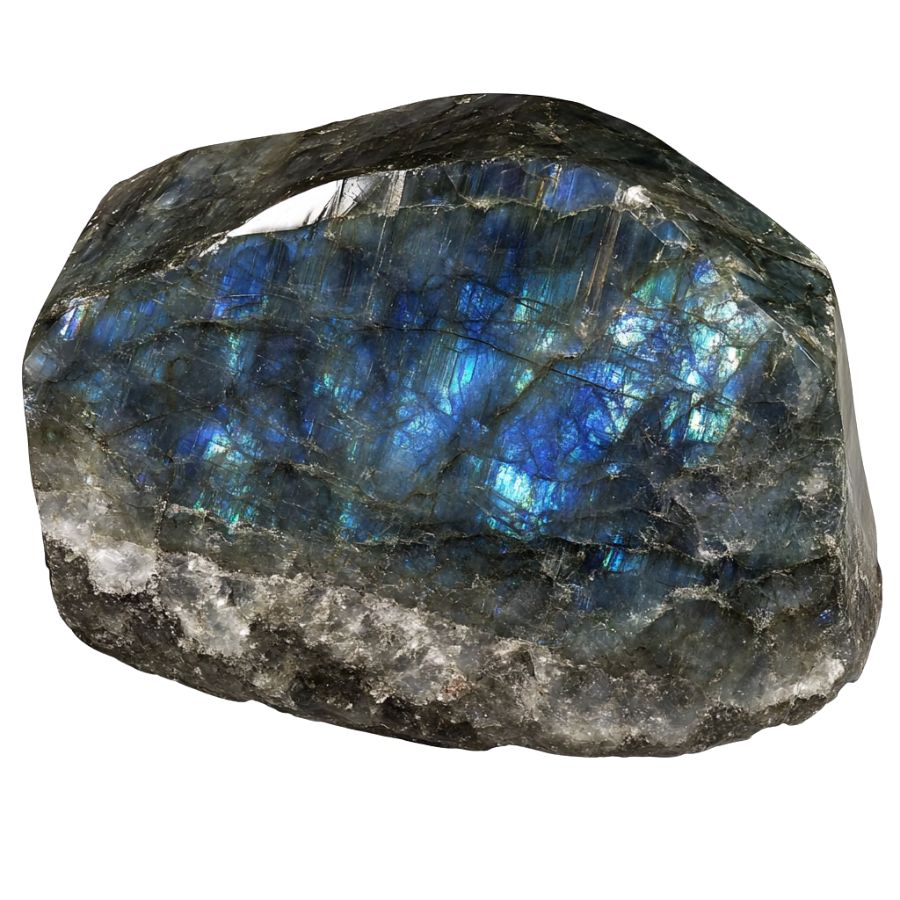
Black Labradorite presents a dramatic dark canvas that emphasizes its colorful display. Bright flashes of color stand out dramatically against the deep black background, creating stunning visual contrast.
Most specimens show multiple colors at once, creating an eye-catching display. These color displays often include electric blues, emerald greens, and golden yellows, all visible simultaneously.
Natural sunlight brings out the boldest displays, while artificial light can highlight subtle color variations. Some specimens also show interesting patterns in how the colors are distributed.
Brown Labradorite
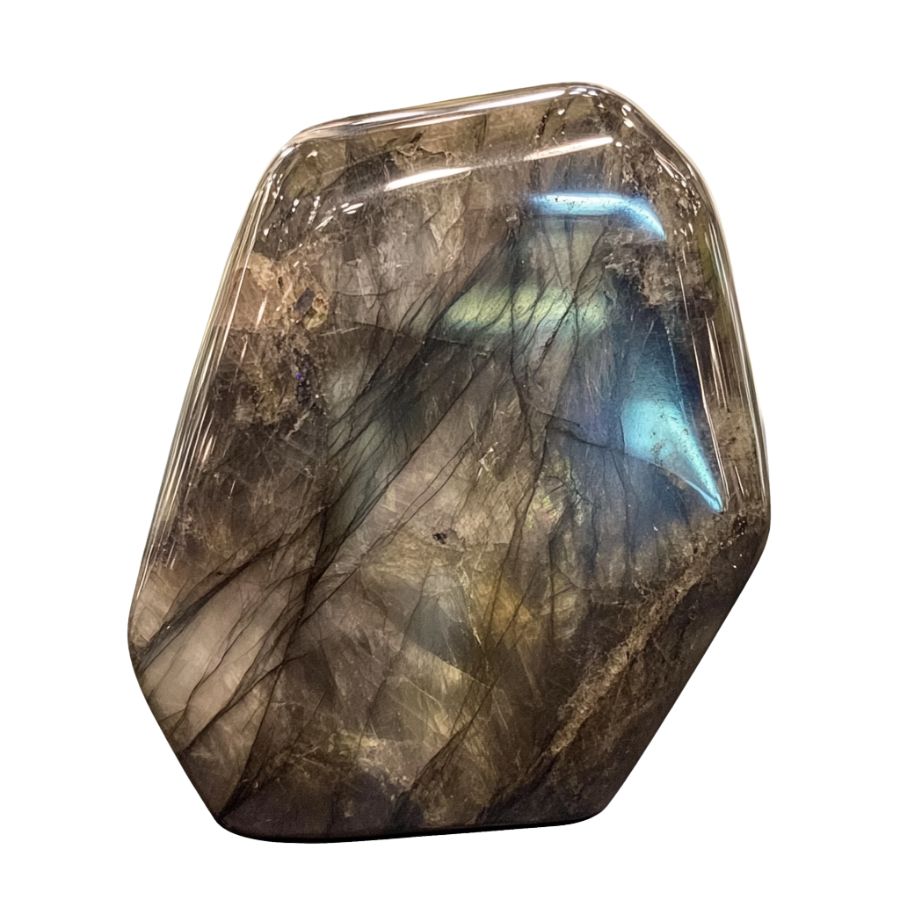
Brown Labradorite features rich earth tones ranging from deep chocolate to warm amber. Peach and orange undertones often appear throughout the stone, creating depth and dimension.
Multiple color zones create interesting patterns within each stone. These patterns can include stripes, swirls, or mottled areas that combine different brown and orange hues.
Subtle iridescence sometimes appears on the surface, adding an unexpected shimmer to the earthy colors. This effect is more subdued than in other varieties but adds an interesting dimension to the stone’s appearance.
If you want REAL results finding incredible rocks and minerals you need one of these 👇👇👇
Finding the coolest rocks in isn’t luck, it's knowing what to look for. Thousands of your fellow rock hunters are already carrying Rock Chasing field guides. Maybe it's time you joined the community.
Lightweight, mud-proof, and packed with clear photos, it’s become the go-to tool for anyone interested discovering what’s hidden under our red dirt and what they've already found.
Join them, and make your next rockhounding trip actually pay off.
What makes it different:
- 📍 Find and identify 140 incredible crystals, rocks, gemstones, minerals, and geodes across the USA
- 🚙 Field-tested across America's rivers, ranchlands, mountains, and roadcuts
- 📘 Heavy duty laminated pages resist dust, sweat, and water
- 🧠 Zero fluff — just clear visuals and straight-to-the-point info
- ⭐ Rated 4.8★ by real collectors who actually use it in the field
What Rough Labradorite Looks Like
Labradorite in its rough form can be tricky to spot, but once you know what to look for, it becomes easier. Here’s how to recognize this fascinating stone in its natural state.
Look for the Signature Flash
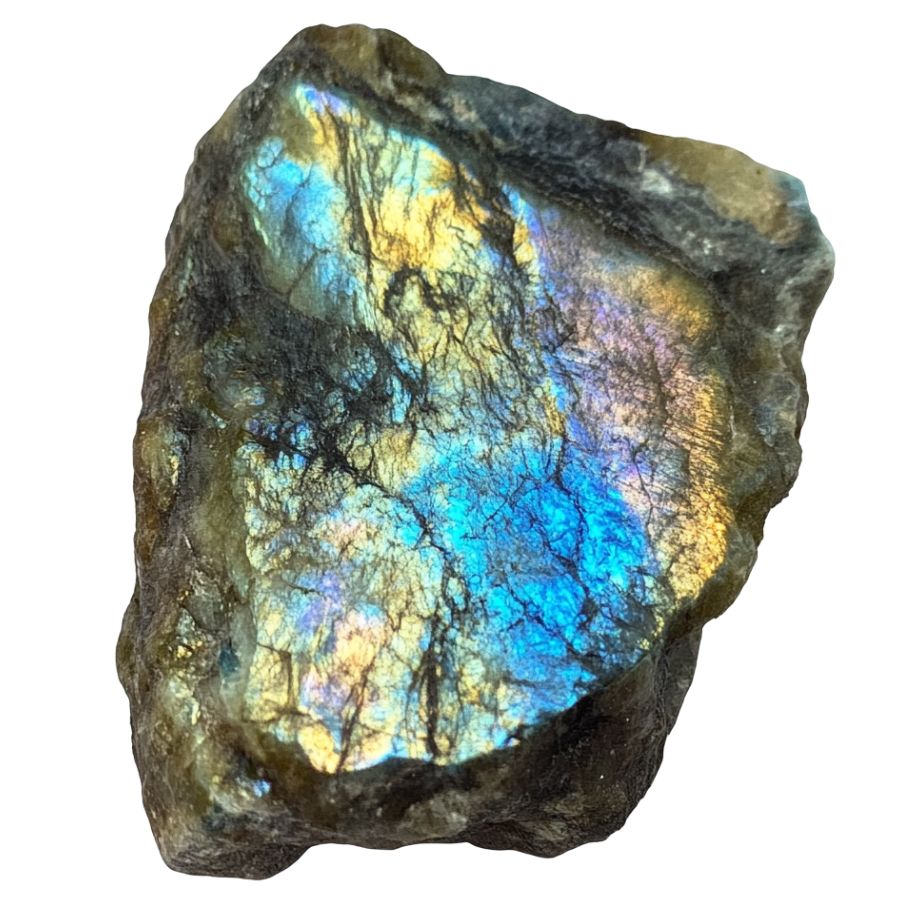
Raw labradorite often shows patches of its famous iridescent flash, even when unpolished. Check dark gray or black areas under direct sunlight – you might catch glimpses of blue, green, or gold shimmer.
Sometimes, you’ll need to wet the surface slightly to see this effect better. The flash isn’t always obvious but usually appears as scattered patches.
Check the Base Color and Texture
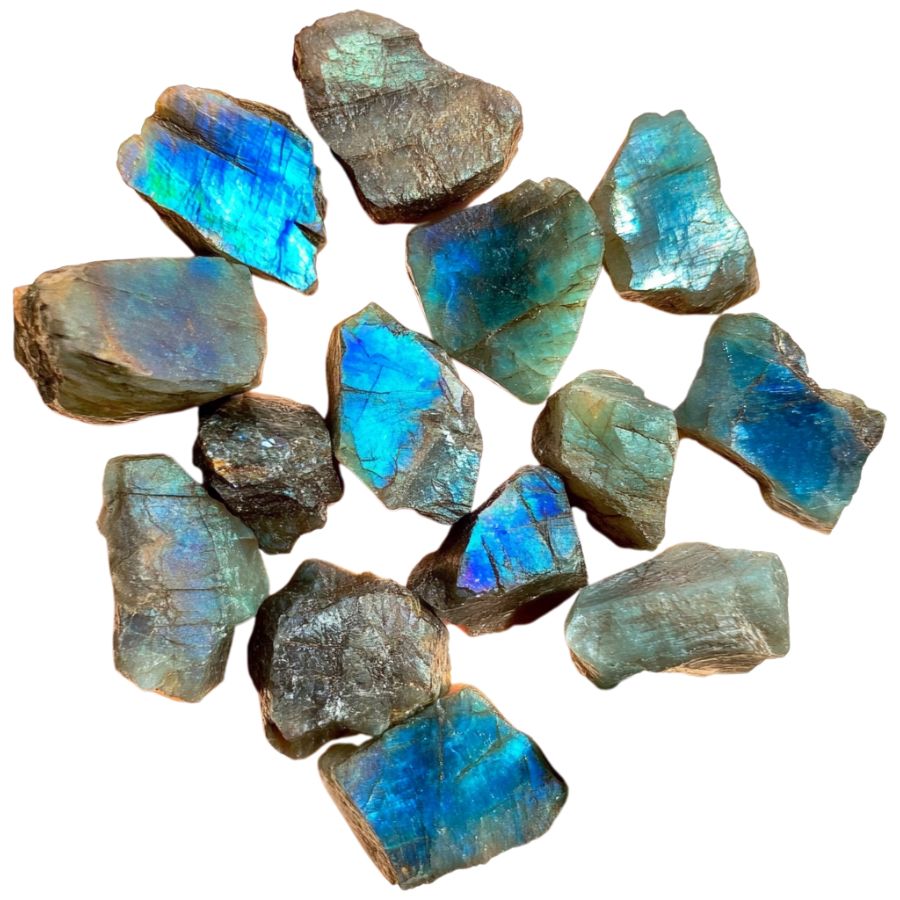
The main body should be dark gray to black, sometimes with a slight greenish tinge. The surface feels smooth but not glossy, similar to unpolished glass.
Look for a slightly bumpy texture with occasional flat surfaces. Fresh breaks will show a more uniform color than weathered surfaces.
Assess the Hardness and Breakage
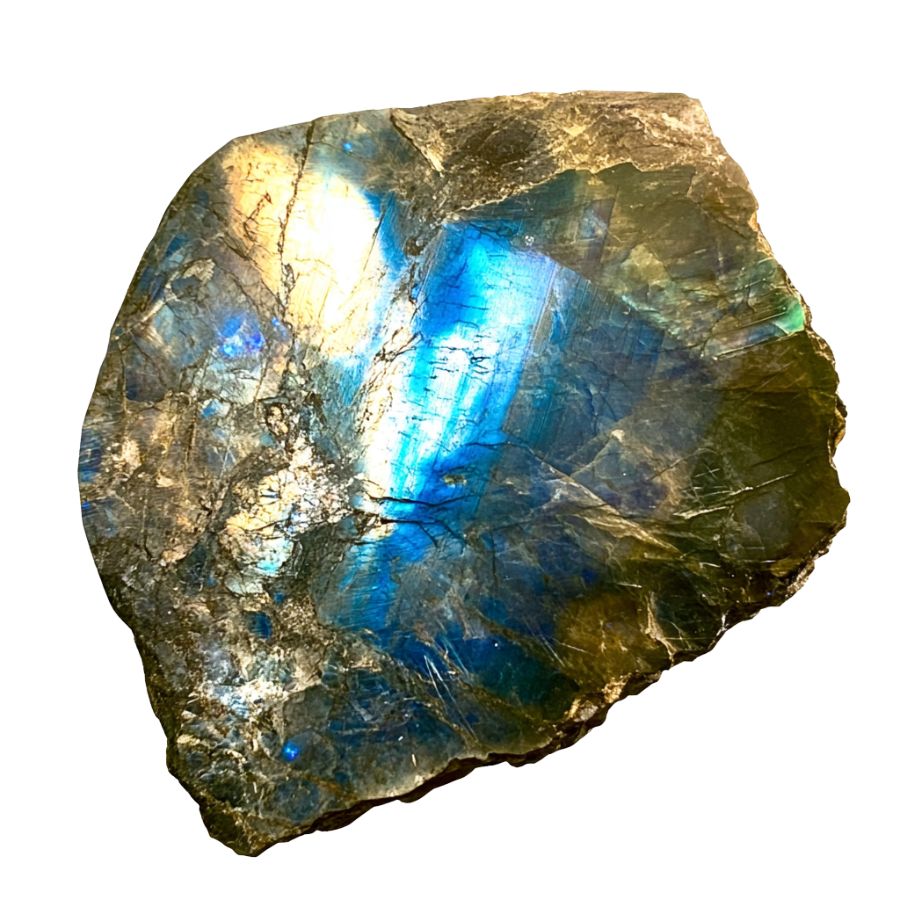
Try scratching the surface with a copper penny – it shouldn’t leave a mark. The stone often breaks with smooth, flat surfaces at distinct angles.
You’ll notice these angular breaks are pretty characteristic, unlike random rough breaks in common rocks.
Test the Translucency
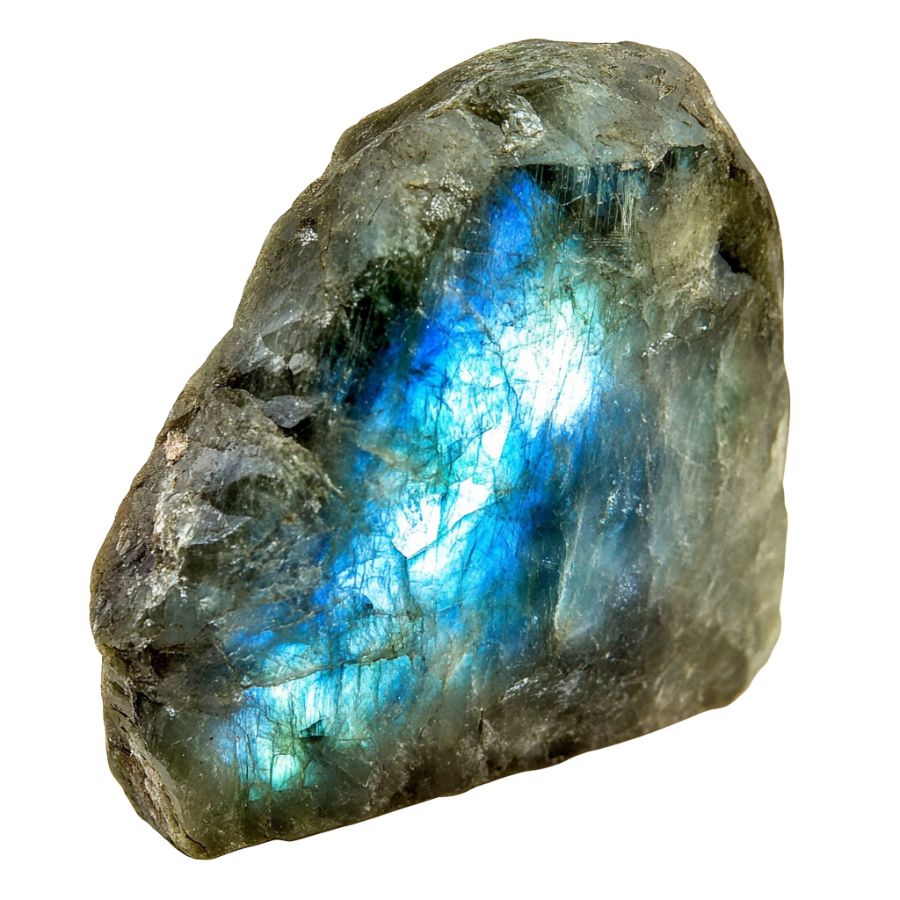
Hold a thin edge up to strong light. Raw labradorite should show some translucency, appearing slightly cloudy rather than completely opaque. The edges might look slightly whitish or gray when light passes through. Thicker pieces will appear darker and more opaque.
The Tools You Will Need
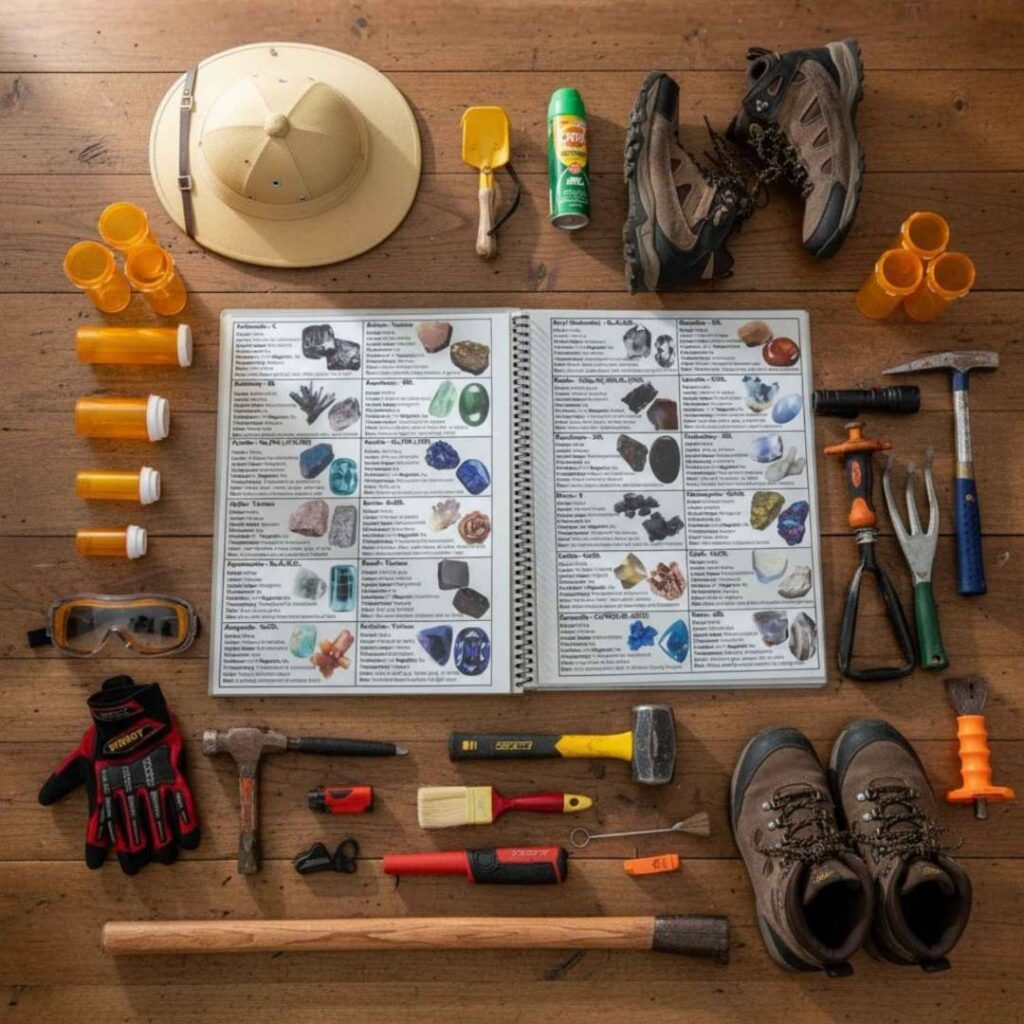
Labradorite’s shimmer can catch your eye from a distance, but spotting it in the field takes more than luck. The right tools help you dig safely, see details clearly, and protect your finds from damage. You don’t need expensive gear to start, just a few essentials that make your hunt smoother and more rewarding.
A Trustworthy Field Identification Guide – Essential
The smartest rockhounds keep one thing in reach at all times: a guide that doesn’t quit in the heat, dust, or mud. With clear images and simple notes, this one makes sense of every strange rock you dig up.
Rock Chasing’s Texas Rocks & Minerals Identification Field Guide is built for that exact job. With hundreds of color photos, waterproof pages, and short, clear descriptions, it helps you identify what you’ve found right where you’re standing.
It keeps you from wasting time guessing or missing something valuable just because it didn’t sparkle at first glance.
You can see HERE why Texas rockhounds are obsessed with this field guide.
Chisel and Hammer – Essential
Labradorite often hides inside tough igneous rock, so you’ll need a small chisel and hammer to free it. This pair lets you split stone cleanly and uncover crystals without breaking them apart. They’re basic tools but make a huge difference when working around hard rock or compacted soil.
Safety Glasses – Recommended
When you’re hammering into rock, even small chips can fly fast. A lightweight pair of safety glasses protects your eyes while keeping your focus on the task. It’s an easy precaution that every beginner should take before the first swing.
Soft Cloth or Wrap – Recommended
Once you’ve freed a piece of labradorite, you’ll want to keep that polished surface safe from scratches. A soft cloth or simple wrap gives your finds a bit of padding in your pack or bucket. It’s a small detail that helps your specimens make it home in perfect condition.
Magnifying Loupe – Optional
A magnifying loupe lets you study labradorite’s color play up close. It’s fun to use in the field, especially when sunlight hits just right. You’ll see details and flashes that make the stone come alive in your hand.
Tips on Where to Look
Labradorite isn’t super common in everyday places, but with some smart searching, you can find it. Here’s where you should look:
Metamorphic Rock Formations
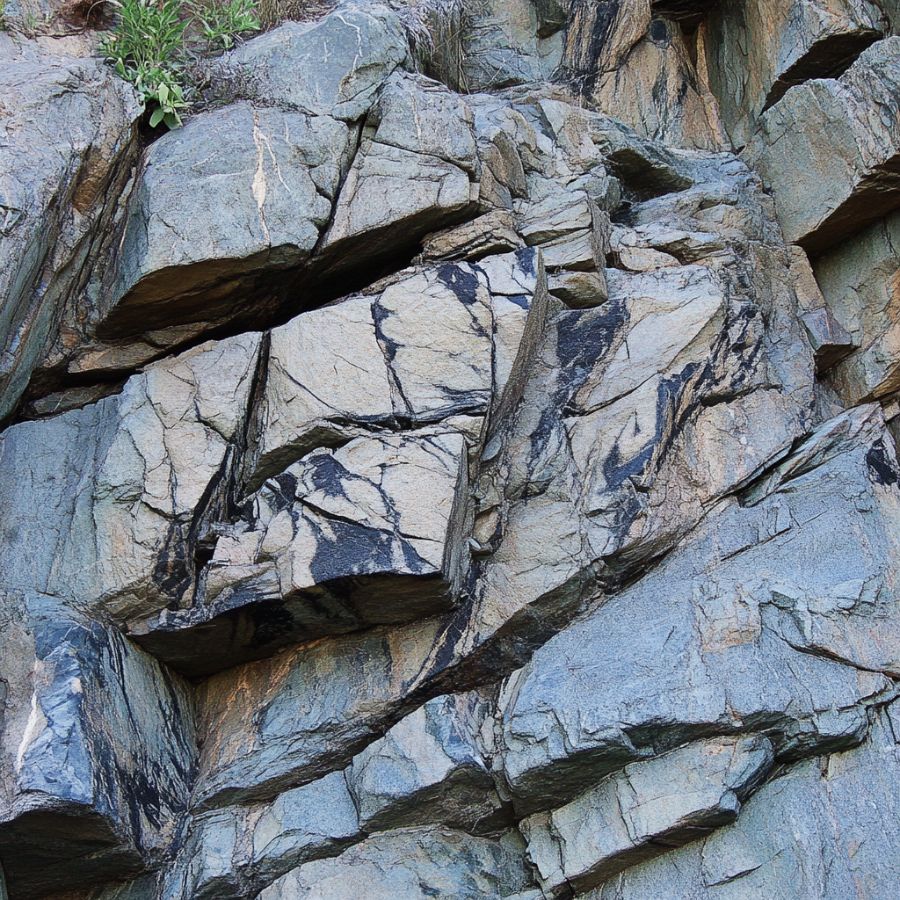
Look for dark-colored rock outcrops. Spot areas with lots of feldspar minerals. Check exposed cliff faces. Sometimes, when the sun hits just right, you might catch that signature blue flash from larger formations that’s a dead giveaway for labradorite presence.
Glacial Deposits
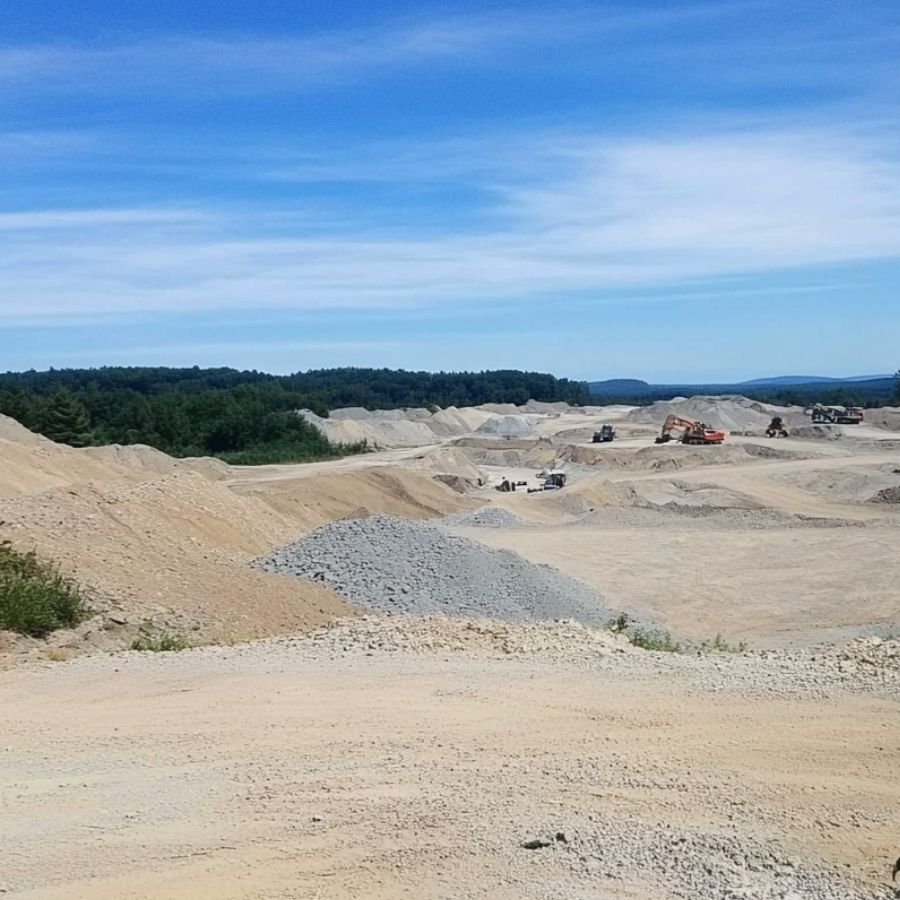
Search river beds after glacial deposits. Check gravel pits near old glacial paths. Look for smooth, dark gray stones mixed with other rocks. These deposits often contain chunks of labradorite that have broken off from larger formations and been carried downstream over thousands of years.
Mining Tailings
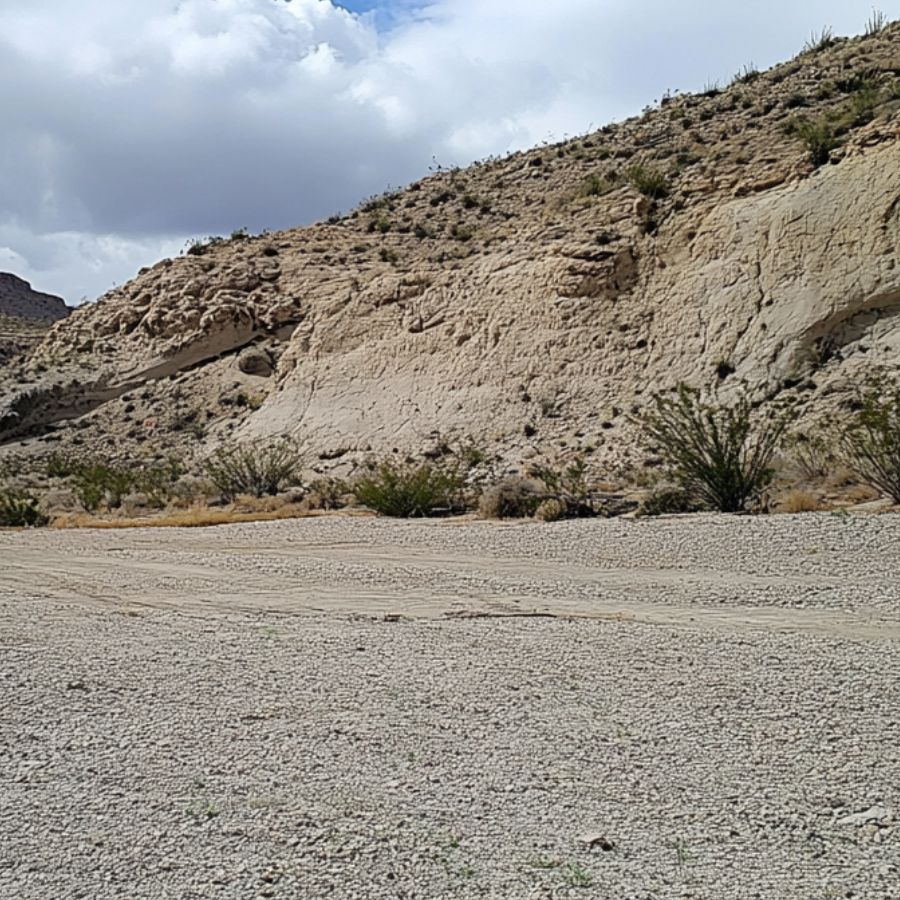
Visit abandoned feldspar mines. Check mine dump areas. Dig through tailings piles. Look for flat, shiny surfaces. The waste rock from old mining operations often contains overlooked pieces of labradorite that weren’t considered valuable during active mining periods but are perfect for collectors.
Stream Beds
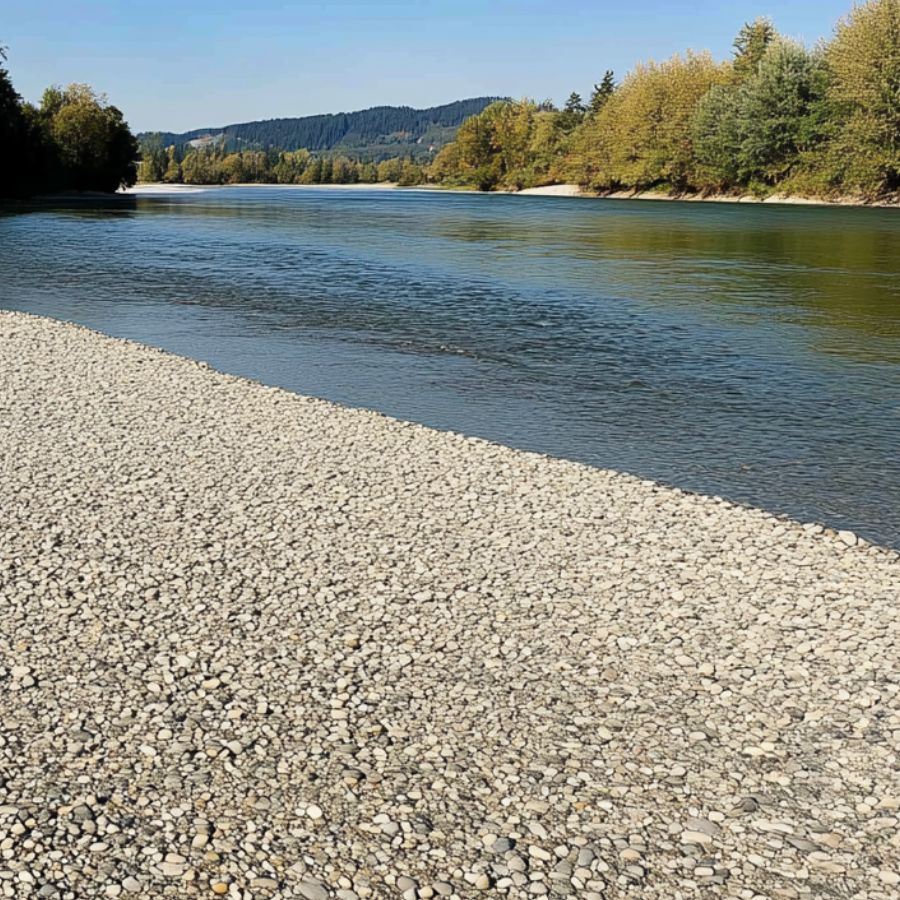
Search clear-water streams. Look under water-worn rocks. Check gravel bars after rain. Spot dark, plate-like stones. The constant water movement often exposes and polishes these stones, making them easier to identify when wet.
Some Great Places To Start
Here are some of the better places in the state to start looking for Labradorite:
Always Confirm Access and Collection Rules!
Before heading out to any of the locations on our list you need to confirm access requirements and collection rules for both public and private locations directly with the location. We haven’t personally verified every location and the access requirements and collection rules often change without notice.
Many of the locations we mention will not allow collecting but are still great places for those who love to find beautiful rocks and minerals in the wild without keeping them. We also can’t guarantee you will find anything in these locations since they are constantly changing.
Always get updated information directly from the source ahead of time to ensure responsible rockhounding. If you want even more current options it’s always a good idea to contact local rock and mineral clubs and groups
Woodward Ranch
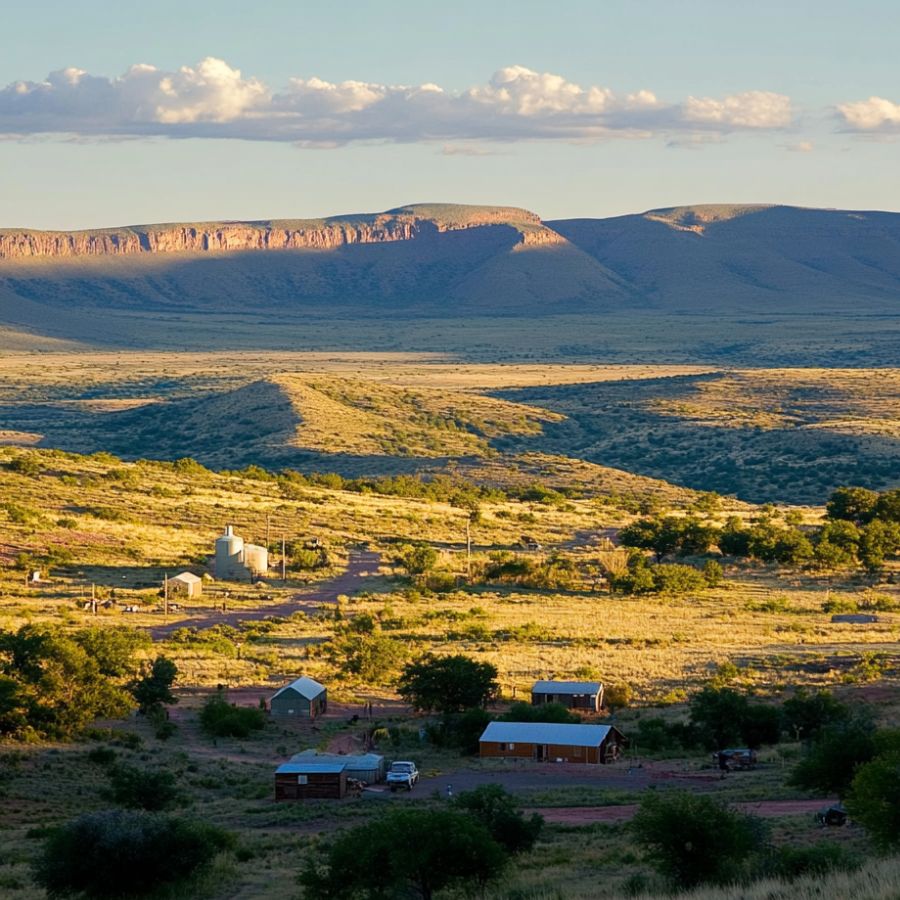
Woodward Ranch sits in the Davis Mountains of Texas. This 7,000-acre ranch is a special place for rock collectors because of its rich volcanic history. About 40 million years ago, a huge volcano covered the area with lava that was more than 750 feet deep.
The best spots to look for labradorite are on the hillsides where pieces have broken free from the volcanic rocks. Some of these pieces are clear enough to be cut into gemstones. Water that seeped into gas bubbles in the ancient lava left behind these beautiful minerals.
The ranch’s unique geology makes it one of Texas’ most important places for finding gemstones. Rock collectors can search through various areas where minerals formed in old lava flows.
You've probably walked past some incredible rocks and minerals. You need this guide 👇👇👇
We've all come across a cool rock that we could have sworn was rare or valuable but couldn't tell what it was.
If you're not 100% confident that you know every rock and mineral in Texas this guide is for you.
The Texas Rocks & Minerals Field Guide helps you ID what you find in seconds, from Hill Country agates to Llano granite, with crisp photos, simple charts, and zero fluff.
→ Grab your copy today and spot your next gem before anyone else does.
What this guide unlocks:
🧭 Confidence in the field — ID rocks fast and move on to the next find
🎒 Lightweight and waterproof — built for trails, not coffee tables
🌅 Weekend adventures — find treasures on rivers, ranches, and roadsides
🤠 Texas pride — explore the real geological beauty of your state
🔥 Motivation — every trip outside feels like a hunt for hidden gems
Alpine Area
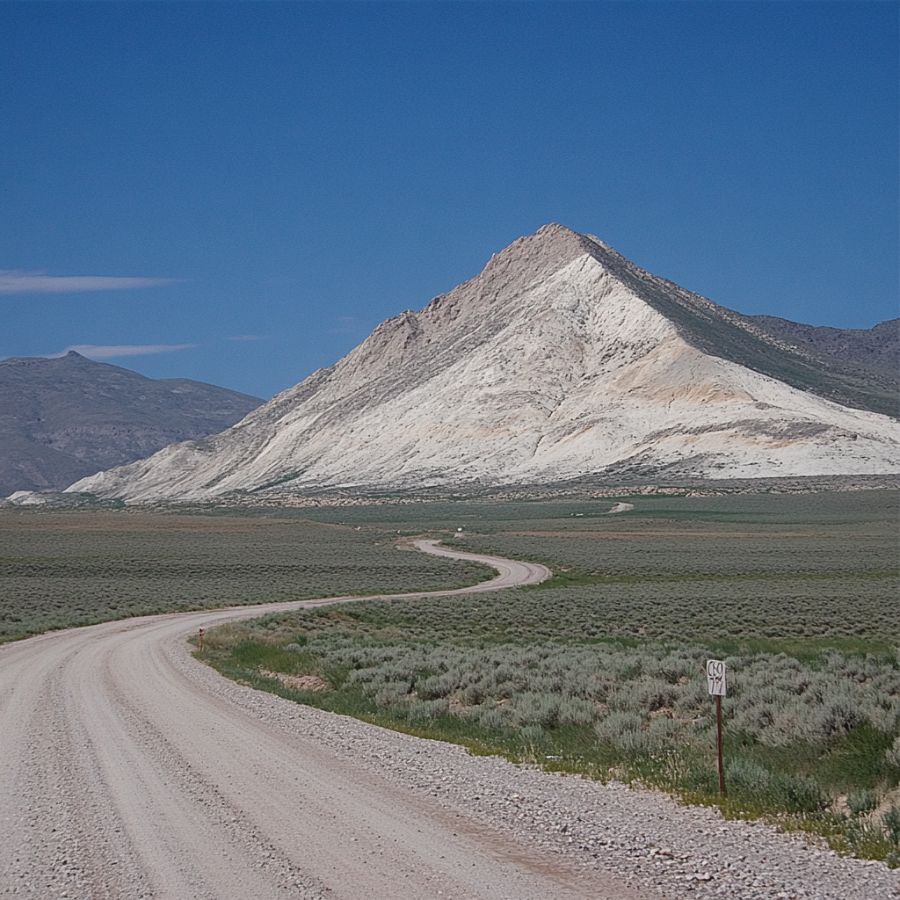
The Alpine Area is located in the southwestern part of Brewster County, Texas, right in the Big Bend region. This area is part of the Chihuahuan Desert and has mountains, valleys, and desert lands all around. Elephant Mountain stands out as a key spot for finding Labradorite in the region.
Local collectors have found not just Labradorite but also agate, opal, and amethyst in these rocks.
Popular hunting spots include the areas around volcanic outcrops and dried stream beds. Many rockhounds focus on the western slopes where erosion has exposed mineral deposits. Some of the best finds have come from areas where dark volcanic rocks meet lighter colored limestone.
Llano River
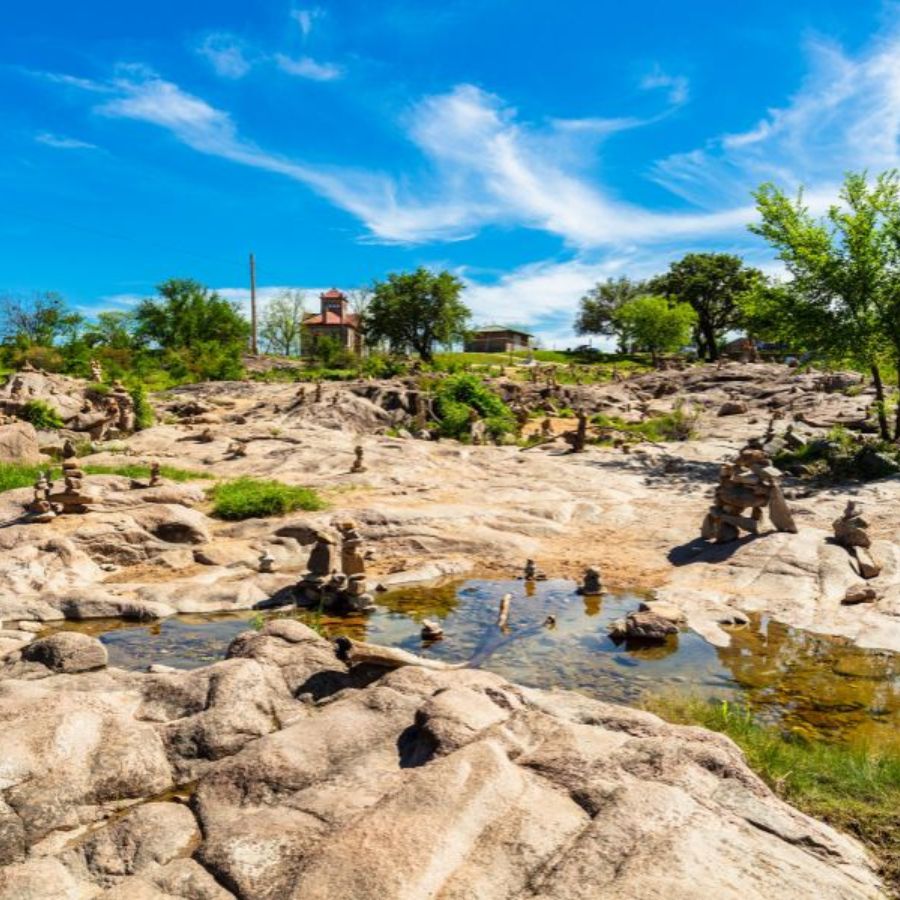
The Llano River flows through the Texas Hill Country, about 80 miles northwest of Austin. This beautiful river cuts through ancient rocks that are over a billion years old.
These rocks hold many treasures like quartz crystals, garnets, and rare pink granite called llanite that’s only found here. Small streams and creeks feed into the main river, creating plenty of spots to search for minerals.
Rock hunters often visit the river’s gravel bars and shallow areas where minerals collect. Many people find success searching near Highway 16 bridge or at Heritage Park in Llano. The river’s constant flow helps wash and polish rocks, making them easier to spot.
During dry seasons, the water level drops, revealing more areas to search along the riverbanks and gravel beds.
Mason Area

Mason County is in the heart of Texas Hill Country, about 110 miles west of Austin. The county is rich in geology thanks to the Llano Uplift, an ancient rock formation that’s over a billion years old.
This special area brings many rare rocks to the surface, making it great for rock collectors. The county is most famous for its blue topaz – it’s even Texas’s state gem!
The soil here comes from old granite and gneiss rocks that broke down over millions of years. These rocks formed deep underground and got pushed up by natural forces. Today, you can find lots of different minerals in Mason County’s creeks and streams.
Promising spots to look for labradorite are in sandy creek beds after it rains. Local rock clubs often plan group trips here because of how many different kinds of stones you can find in one place.
Rio Grande

The Rio Grande area in Presidio County sits at the southwestern edge of Texas, right next to Mexico. This part of Texas has amazing rock formations thanks to its location in the Chihuahuan Desert. Many rock collectors visit this area to search for different minerals and gems.
Labradorite can be found in the gravels along the Rio Grande River. These rocks were carried down by the river over many years. Big Bend National Park, which is close by, shows how volcanic activity shaped this region long ago. The area has deep canyons, flat-topped mesas, and lots of volcanic rocks.
People looking for Labradorite should check the river gravels near Terlingua Creek. This spot is known for having different types of minerals. Hot springs in the area created perfect conditions for forming these special rocks.
Places Labradorite has been found by County
After discussing our top picks, we wanted to discuss the other places on our list. Below is a list of the additional locations along with a breakdown of each place by county.
| County | Location |
| Brewster | Stillwell Ranch |
| Mason | Garner Seaquist Ranch |
| Llano | Barringer Hill |
| Brazos | Bryan-College Station Area |
| Presidio | East Needle Peak |
| Palo Pinto | Mineral Wells Fossil Park |
| Briscoe | Lake Mackenzie |
| Brewster | Terlingua |
| Mason | Lindsay Ranch |
| Brewster | Big Bend Area |
| Presidio | Marfa |
| Brewster | Ritchie Ranch |
| Brewster | Walker Ranch |


